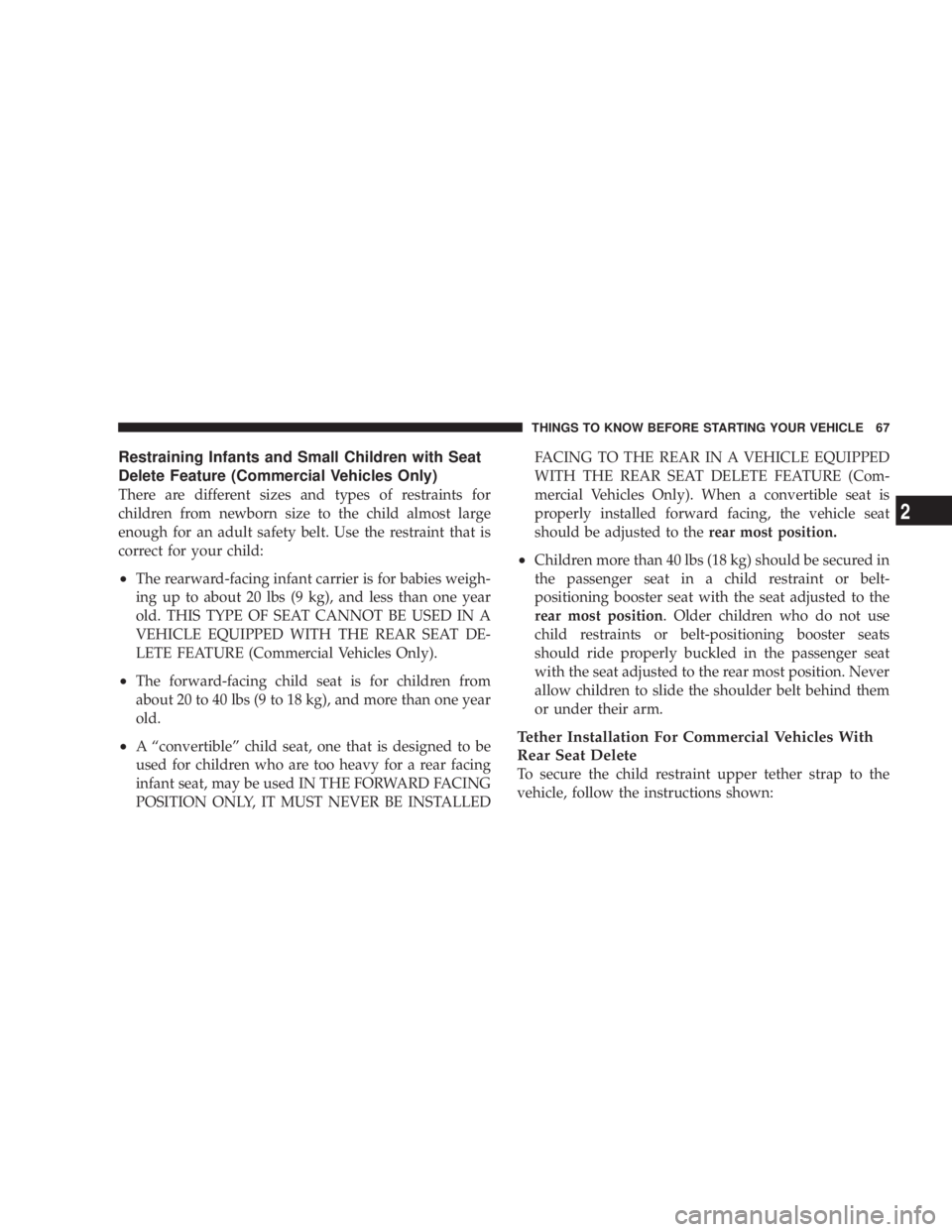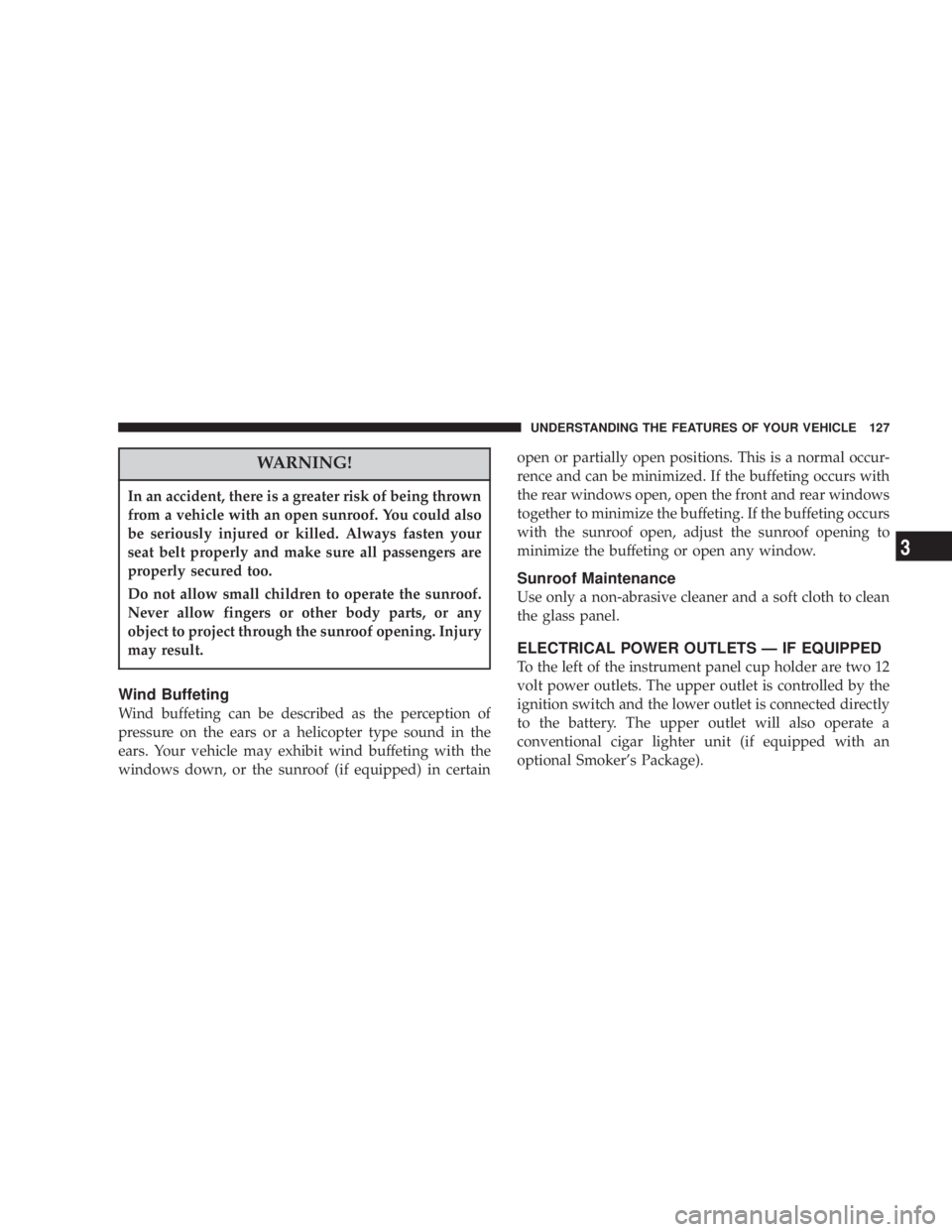Page 66 of 397

Transporting Pets
Airbags deploying in the front seat could harm your pet.
An unrestrained pet could be thrown about and possibly
injured, or injure a passenger during panic braking or in
a collision.
Pets should be restrained in the rear seat in pet harnesses
or pet carriers that are secured by seat belts.
REAR SEAT DELETE FEATURE (COMMERCIAL
VEHICLES ONLY) Ð IF EQUIPPED
Commercial cargo vehicles are not designed for use as a
family vehicle and are not intended for carrying children
in the front passenger seat. However, if you must carry a
child in a vehicle without a rear seat, the passenger seat
should be moved to the full rearward position and the
child must be in a proper restraint system based on it's
age, size and weight. NEVER carry a child in a rear facing infant carrier in a vehicle without rear seats. In an
accident, serious injury or death may occur from the
deploying passenger air bag.
This vehicle is equipped with a child restraint tether
anchor located on the floor, behind the front passenger
seat. Use this tether anchor to secure only forward
facing child restraints equipped with an upper tether
strap.
WARNING!Rear Facing Infant restraints must never be secured
in the passenger seat of a vehicle with a passenger
airbag. In an accident a passenger airbag may deploy
causing severe injury or death to infants riding in
rear facing infant restraints.66 THINGS TO KNOW BEFORE STARTING YOUR VEHICLE
Page 67 of 397

Restraining Infants and Small Children with Seat
Delete Feature (Commercial Vehicles Only)
There are different sizes and types of restraints for
children from newborn size to the child almost large
enough for an adult safety belt. Use the restraint that is
correct for your child:
² The rearward-facing infant carrier is for babies weigh-
ing up to about 20 lbs (9 kg), and less than one year
old. THIS TYPE OF SEAT CANNOT BE USED IN A
VEHICLE EQUIPPED WITH THE REAR SEAT DE-
LETE FEATURE (Commercial Vehicles Only).
² The forward-facing child seat is for children from
about 20 to 40 lbs (9 to 18 kg), and more than one year
old.
² A ªconvertibleº child seat, one that is designed to be
used for children who are too heavy for a rear facing
infant seat, may be used IN THE FORWARD FACING
POSITION ONLY, IT MUST NEVER BE INSTALLED FACING TO THE REAR IN A VEHICLE EQUIPPED
WITH THE REAR SEAT DELETE FEATURE (Com-
mercial Vehicles Only). When a convertible seat is
properly installed forward facing, the vehicle seat
should be adjusted to the rear most position.
² Children more than 40 lbs (18 kg) should be secured in
the passenger seat in a child restraint or belt-
positioning booster seat with the seat adjusted to the
rear most position . Older children who do not use
child restraints or belt-positioning booster seats
should ride properly buckled in the passenger seat
with the seat adjusted to the rear most position. Never
allow children to slide the shoulder belt behind them
or under their arm.
Tether Installation For Commercial Vehicles With
Rear Seat Delete
To secure the child restraint upper tether strap to the
vehicle, follow the instructions shown: THINGS TO KNOW BEFORE STARTING YOUR VEHICLE 67
2
Page 76 of 397

N Erasing Homelink Buttons ...............124
N Reprogramming a Single Homelink Button . . . 124
N Security ............................124
m Power Sunroof Ð If Equipped .............125
N Express Open Feature ..................126
N Wind Buffeting .......................127
N Sunroof Maintenance ...................127
m Electrical Power Outlets Ð If Equipped .......127
N Electrical Outlet Use With Engine Off .......129
m Convenience Tray Drawer And Cup Holders . . . 129
N Instrument Panel Cup Holders ............129 N Convenience Tray And Optional Smoker's
Package Kit .........................130
N Rear Cupholders ......................130
m Storage ..............................132
N Front Seat Storage Bin Ð If Equipped .......132
N Removable Floor Console Ð If Equipped ....132
N Rear Compartment Storage Bins ...........135
N Cargo Area Storage ....................135
N Cargo Organizer Ð If Equipped ...........136
m Roof Luggage Rack Ð If Equipped ..........139
m Load Leveling System ...................14176 UNDERSTANDING THE FEATURES OF YOUR VEHICLE
Page 97 of 397
Next, push to the left the safety catch located under the
front edge of the hood, near the center.
Use the hood prop rod to secure the hood in the open
position. To prevent possible damage, do not slam the hood to
close it. Lower the hood until it is open approximately 30
cm (12 inches) and then drop it. This should secure both
latches. Never drive your vehicle unless the hood is fully
closed, with both latches engaged.
WARNING!If the hood is not fully latched, it could fly up when
the vehicle is moving and block your forward vision.
You could have a collision. Be sure all hood latches
are fully latched before driving. UNDERSTANDING THE FEATURES OF YOUR VEHICLE 97
3
Page 123 of 397

and, depending on the brand of the garage door opener
(or other rolling code equipped device), repeat this
sequence a third time to complete the programming.
HomeLink should now activate your rolling code
equipped device.
NOTE: To program the remaining two HomeLink but-
tons, begin with 9 Programming 9 step two. Do not repeat
step one . For questions or comments, please contact
HomeLink at www.homelink.com or 1-800-355-3515 .
Canadian Programming/Gate Programming
Canadian radio-frequency laws require transmitter sig-
nals to 9 time-out 9 (or quit) after several seconds of
transmission which may not be long enough for
HomeLink to pick up the signal during programming.
Similar to this Canadian law, some U.S. gate operators are
designed to 9 time-out 9 in the same manner. If you live in Canada or you are having difficulties
programming a gate operator by using the 9 Program-
ming 9 procedures (regardless of where you live), replace
( Programming HomeLink ( step 3 with the following:
NOTE: If programming a garage door opener or gate
operator, it is advised to unplug the device during the
9 cycling 9 process to prevent possible overheating.
3. Continue to press and hold the HomeLink button
while you press and release every two seconds ( 9 cycle 9 )
your hand-held transmitter until the frequency signal has
successfully been accepted by HomeLink. (The indicator
light will flash slowly and then rapidly.) Proceed with
9 Programming 9 step four to complete.
Using HomeLink
To operate, simply press and release the programmed
HomeLink button. Activation will now occur for the
trained device (i.e. garage door opener, gate operator,
security system, entry door lock, home/office lighting, UNDERSTANDING THE FEATURES OF YOUR VEHICLE 123
3
Page 124 of 397

etc.). For convenience, the hand-held transmitter of the
device may also be used at any time. In the event that
there are still programming difficulties or questions,
contact HomeLink at: www.homelink.com or 1-800-355-
3515 .
Erasing HomeLink Buttons
To erase programming from the three buttons (individual
buttons cannot be erased but can be 9 reprogrammed 9 -
note below), follow the step noted:
² Press and hold the two outer HomeLink buttons until
the indicator light begins to flash-after 20 seconds.
Release both buttons. Do not hold for longer that 30
seconds. HomeLink is now in the train (or learning)
mode and can be programmed at any time beginning
with 9 Programming 9 - step 2. Reprogramming a Single HomeLink Button
To program a device to HomeLink using a HomeLink
button previously trained, follow these steps:
1. Press and hold the desired HomeLink button. Do
NOT release the button.
2. The indicator light will begin to flash after 20 seconds.
Without releasing the HomeLink button, proceed with
9 Programming 9 step 2
For questions or comments, contact HomeLink at:
www.homelink.com or 1-800-355-3515 .
Security
If you sell your vehicle, be sure to erase the frequencies.
To erase all of the previously trained frequencies, hold
down both outside buttons until the green light begins to
flash.124 UNDERSTANDING THE FEATURES OF YOUR VEHICLE
Page 127 of 397

WARNING!In an accident, there is a greater risk of being thrown
from a vehicle with an open sunroof. You could also
be seriously injured or killed. Always fasten your
seat belt properly and make sure all passengers are
properly secured too.
Do not allow small children to operate the sunroof.
Never allow fingers or other body parts, or any
object to project through the sunroof opening. Injury
may result.
Wind Buffeting
Wind buffeting can be described as the perception of
pressure on the ears or a helicopter type sound in the
ears. Your vehicle may exhibit wind buffeting with the
windows down, or the sunroof (if equipped) in certain open or partially open positions. This is a normal occur-
rence and can be minimized. If the buffeting occurs with
the rear windows open, open the front and rear windows
together to minimize the buffeting. If the buffeting occurs
with the sunroof open, adjust the sunroof opening to
minimize the buffeting or open any window.
Sunroof Maintenance
Use only a non-abrasive cleaner and a soft cloth to clean
the glass panel.
ELECTRICAL POWER OUTLETS Ð IF EQUIPPED
To the left of the instrument panel cup holder are two 12
volt power outlets. The upper outlet is controlled by the
ignition switch and the lower outlet is connected directly
to the battery. The upper outlet will also operate a
conventional cigar lighter unit (if equipped with an
optional Smoker's Package). UNDERSTANDING THE FEATURES OF YOUR VEHICLE 127
3
Page 136 of 397
The liftgate sill plate has a raised line with the statement
ªLoad To This Lineº. This line indicates how far rearward
cargo can be placed without interfering with liftgate
closing. Cargo Organizer Ð If Equipped
Long wheel base vehicle with rear air conditioning may
be equipped with a cargo organizer that mounts on the
floor behind the rear seat. Items may be placed on the flat
surface or stored in the three storage compartments.
WARNING!² To avoid tipping, lock the shelf securely in all
positions.
² Do not drive this vehicle with the liftgate open, or
use the shelf as a seat.
² Failure to follow these warnings could result in
serious or fatal injury.
1. To raise the cargo organizer pull up on the handle and
pull towards the rear of the vehicle.136 UNDERSTANDING THE FEATURES OF YOUR VEHICLE